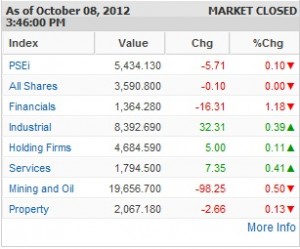MANILA, Philippines—Customers of Manila Electric Co., the country’s biggest power distributor, can expect a slight increase of roughly 12 centavos per kilowatt-hour in their electricity bills in October, reflecting a net hike in the generation and transmission charges, as well as other pass-through costs and taxes.
This meant that households consuming 100 kWh every month can expect an increase of P11.35 in their power bills while those that use up 200 kWh and 300 kWh will have to pay an additional P23.70 and P35.56 this month, according to Lawrence S. Fernandez, assistant vice president and head of utility economics of Meralco.
Households consuming 400 kWh and 500 kWh monthly would have to shell out another P47.41 and P59.26 for their October power bills, respectively, Fernandez further said in a text message.
In a statement issued on Monday, Meralco said that the latest adjustment in the electricity bills resulted largely from an increase of 10 centavos per kWh in the generation charge to P5.50 per kWh. This was attributed to the higher charges from the Wholesale Electricity Spot Market (WESM), which went up by P1.16 per kWh during the supply month of September. Power consumption made in September are billed and reflected in October.
“After the holidays and rainy weather of August led to depressed demand for power, September saw an increase in electricity consumption. On the other hand, there was a reduction in available generation capacity and the output of coal-fired plants was restricted due to repairs and maintenance. These eventually led to increases in WESM prices,” the distribution utility explained.
The higher WESM charges were partly offset by lower prices from independent power producers (IPPs), whose rates decreased by 9 centavos per kWh, and the lower costs of power from state-run National Power Corp., which registered a decrease of 22 centavos per kWh.
During the supply month of September, Meralco sourced 49 percent of its electricity requirements from Napocor; 44.1 percent from the IPPs; and 6.9 percent from the WESM.
Meanwhile, Meralco further disclosed that the transmission charge slightly rose by 4 centavos per kWh, due to higher ancillary generation costs. Ancillary services referred to the “standby” power supply that can be tapped in case regular supply to the grid falls short of the requirement. This power supply, however, is priced at a premium compared to power sourced via bilateral contracts or WESM.
With the higher generation and transmission charges, the system loss charge similarly increased by 2 centavos per kWh, according to Meralco.
Meralco reiterated that it did not and would not earn from the generation and other pass-through charges.
For instance, the payment for the generation charge, which is a pass-through cost for Meralco, goes to the power producers such as Napocor, the IPPs and WESM.
Meanwhile, the transmission and system loss charges are remitted to the National Grid Corp. of the Philippines and generating companies. Meralco’s own charges (distribution, supply and metering) only account for about 16 percent of the total electricity bill. The rest of the pass-through costs include taxes, subsidies and other charges.


